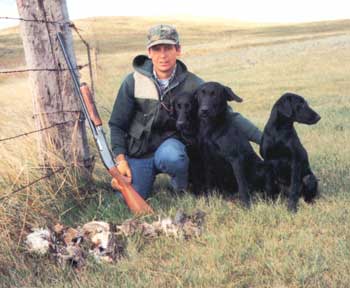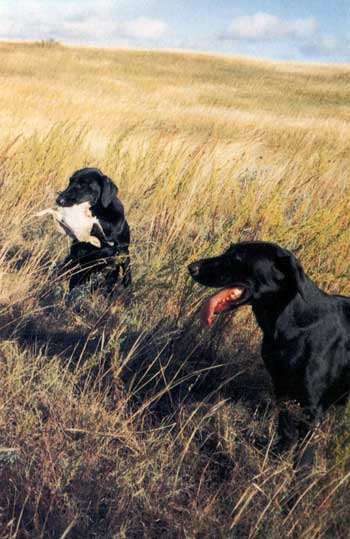|
Labs and Sharptails on the North Dakota Prairie
|
||||
 The author with his three Labs: Bee, Din and Do. With pasture on the right and CRP on the left, the author walks the CRP in the morning, and pasture gullies and brush patches during midday. |
In hunting sharptails in North Dakota, you have to deal with large sections of prairie and pasture. The local residents party hunt with five to ten hunters in a group. They cover a lot of ground with these large groups and naturally find birds due to the fact they are blanketing an area. At first, I was under the impression that due to the vast area and the wily nature of the sharptail, the only way to hunt them was in a large group. After a few seasons of this type of hunting, I began to observe location patterns and bird habits that do not require party hunting. Party hunting had never been my thing. I had the one-on-one dog work.
North Dakota sharptail is a plains grassland species found in uncultivated areas interspersed with small patches of brush or tree lines. As a general rule, I look for areas with rugged rolling topography that have limited habitat loss due to the plow. The areas I key on have a combination pasture, CRP fields, livestock ponds or sloughs in the area and a few scattered small grain fields. The sharptail feed on berries, seeds, small grains and grasshoppers, if available.
 |
Hunting sharptails is a lot like walleye fishing. We call it structure hunting. When you fish for walleye, lake structure is the key element for holding fish during certain times of the day and season. Grouse are no different. By observing the habitat and field contours, you can eliminate up to 80 percent of a field that not hold birds. Remember, we are not using a wide ranging dog that would cover a section in a short amount of time. Our intent is to maximize our hunting time over birds rather than wearing ourself and retrievers out on a long walk. Let’s study a few locational patterns and tips that work well for us the first three weekends of the September hunting season.
Retrievers work well for grouse if you know how to read habitat and can identify sharptail location as it relates to the time of day and weather patterns. If you follow a few of these basic tips, you will not have to party hunt or become a road warrior (someone who loves to drive and spot birds off the road). Sharptail hunting can offer you early season enjoyment and excellent fieldwork for you and your retrievers prior to the October pheasant opener.
• During windy weather (which is probably
90 percent of the time in North Dakota), walk only the leeward side
of the field
contours.
• As the wind calms, walk the ridges or tops
of field contours.
• Hot, dry weather will bunch the
ridges or tops of field contours.
• Find the highest
hill in the area. And observe bird movement at sunrise and sunset.
• Walk
brushy pastures and gullies during wet weather or the midday doldrums.
• If
the ground is wet, look for bare patches; grouse do not like to
get wet.
• As you walk a heavy covered field, look for
breaks of sparse cover on small ridges. Sharptails like
the visibility
offered
on these
areas as
they leisurely
eat grasshoppers, seeds and berries.
• If the birds are
a late hatch, they will hold extremely tight, so make your dog
work over a scented area
in detail.
• As the season progresses and sharptails
become wary, keep all talk, dog commands, and whistle
noise to a
minimum. Learn
to
handle your
dogs with
hand signals.
• Sharptails will not leave a running scent
trail like pheasants. Expect spot-scented areas.
Keep close to
your dog and always
walk into the
wind when possible.
• Open the feed sack of the first
few grouse you shoot. Identify the types of food
and look for
these locations.
• Once you have found birds in a certain
location, practice catch/release,
that is, flush and
release. You can shoot
birds in a good habitat
area year after
year if you leave a few birds for seed.
TIPS
Videos and Articles on Kennel Design and Dog Training.
INSTALL
Pet Door Installation Instructions
with Training Tips.
BLOG
News, Features and More! Come Visit.
Thank You, Lance & Marcie
|
|
1-800-789-0203 • 701-354-7700 • Fax
701-354-0117
13835 34th St NW • Bismarck, ND 58503 International 701-354-7700 Copyright © 1992-2024 Gun Dog House Door® Inc. |



